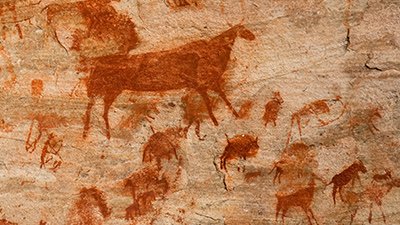
Stone Axes Push Anthropological Views on Humans Back in Time
Homo erectus tool time tinkers with anthropological thought.
News Source
Homo erectus is believed by evolutionary paleontologists to be a human precursor that evolved in Africa about two million years ago and migrated to Europe and Asia. Acheulian stone tools—hand axes—are associated with Homo erectus. “The origin of the Acheulian is thought to have closely coincided with major changes in human brain evolution, allowing for further technological developments.”1
“The Acheulian tools represent a great technological leap,” according to geologist Dennis Kent. Careful crafting of tools denotes the ability to plan for the future. Evolutionists associate these tools with an advance in hominid evolution. Paleoanthropologists therefore wish to determine how early the Acheulian technology developed.
Research just published in Nature reveals some surprisingly early dates for Acheulian artifacts from the western shore of Lake Turkana in Kenya. Researchers found artifacts of both Acheulian and much simpler Oldowan configurations at Kokiselei. The artifacts did not have any human fossils with them, but because a Homo erectus fossil had been found in the same geological stratum on the eastern shore, they assumed the artifacts were truly of Homo erectus origin.
Geologists dated the sedimentary rock in which the hand axes were found using a combination of dating methods. The argon-dated volcanic KBS tuff is about 1–15 meters below the Kokiselei site, and an argon-dated volcanic layer on the other side of Lake Turkana has an elevation around 150 meters higher than the site. The age of the artifacts was estimated by assuming a uniform sedimentation rate between these argon-dated layers. Paleomagnetic analyses of polarity reversals were also used to date blocks of sedimentary rock from the site. The researchers concluded these Acheulian tools are a record-breaking 1.76 million years old. “We suspected that Kokiselei was a rather old site, but I was taken aback when I realized that the geological data indicated it was the oldest Acheulian site in the world,” said geologist Christopher Lepre, the study’s lead author.
Anthropologists have previously found Acheulian tools dated 1.4 million years old in Konso, Ethiopia, and 1–1.5 million years ago in India. However, the Homo erectus excavation in Dmanisi, Georgia, has much simpler tools. So “Why,” geologist Dennis Kent wonders, “didn’t Homo erectus take these tools with them to Asia?” And how, the researchers wonder, should they explain the coexistence of the Acheulian with the more primitive Oldowan?
While evolutionists ponder ways to fit the new data into their evolutionary models, we should take a look at the preconceptions underlying their results. The dating methods involved here are based on an elaborate series of assumptions and some dates which are controversial even among evolutionists.
First of all, argon dating requires calibration against specimens of known age. Those known ages, however, are derived from other radiometric dating methods. Those methods in turn are based on a set of unprovable assumptions.2 Therefore, circular reasoning is built into the argon dating method.
Second, the article in Nature specifies the rocks being examined by paleomagnetic analyses were from a stratified sedimentary complex of mudstone, claystone, and siltstone consistent with sediment washed in by flooding. But the magnetic reversals within those sediments were calibrated by comparison to the paleomagnetic timescale derived from volcanic rocks in other parts of the world.3 The magnetite grains in the volcanic layers record the polarity of the earth’s magnetic field at the times the lavas cooled, but these sediments were washed in as disorganized fragments, so they cannot be reasonably compared to the volcanic material.
Third, the dating of the relevant rocks in the Turkana region has been the subject of much contention among evolutionists. For instance, the KBS tuff beneath the Kokiselei region has been re-dated numerous times since the 1960s in order to obtain results more in line with evolutionary expectations. Read more about that interesting saga at “The Pigs Took It All.”
We must certainly question the reliability of dating results which are not only based on circular reasoning, but which have been routinely repeated until more pleasing results were obtained.
Furthermore, the Homo erectus skull found east of Lake Turkana by Lepre and Kent, co-authors of this study, also came from an area known for its controversial dating. Olduvai Gorge, final resting place of a number of Homo erectus bones, has been re-dated multiple times because “precise age estimates have been elusive.”4 As Lepre and Kent reported, “A problematic magnetostratigraphy for the Koobi Fora Formation has contributed to debates on the evolutionary implications for early hominin fossils.”5 We must certainly question the reliability of dating results which are not only based on circular reasoning, but which have been routinely repeated until more pleasing results were obtained.
Actually, when stripped of the sensational dating, the archaeological findings at Kokiselei are consistent with a biblical understanding of history. These fossils and artifacts are in Pleistocene layers6 deposited during the Ice Age. In fact, the sediments of this region were deposited at a time when the climate was extremely wet and beginning to dry “in response to global climate forcing.”7 These findings are thus consistent with the early post-Flood world. The Ice Age was triggered by the global Flood. Furthermore, the mixture of artifacts at Lake Turkana and the evidence of scattered Acheulian artifacts around Eurasia and Africa is consistent with fully human groups of people—those now being called Homo erectus among others—scattering from the tower of Babel. There is no need to explain the dates because they are contrived from unsupportable assumptions. The Bible makes sense of the rest of the findings.
Further Reading
- Get Answers: Human Evolution
For More Information: Get Answers
Remember, if you see a news story that might merit some attention, let us know about it! (Note: if the story originates from the Associated Press, FOX News, MSNBC, the New York Times, or another major national media outlet, we will most likely have already heard about it.) And thanks to all of our readers who have submitted great news tips to us. If you didn’t catch all the latest News to Know, why not take a look to see what you’ve missed?
(Please note that links will take you directly to the source. Answers in Genesis is not responsible for content on the websites to which we refer. For more information, please see our Privacy Policy.)
Footnotes
- Christopher J. Lepre et al., “An Earlier Origin for the Acheulian,” Nature 477 (September 1, 2011): 82–85, doi:10.1038/nature10372.
- See “Radiometric Dating: Back to Basics,” “Radiometric Dating: Problems with the Assumptions,” and “Radiometric Dating: Making Sense of the Patterns.”
- Lepre et al., “An Earlier Origin for the Acheulian.”
- Marvin L. Lubenow, Bones of Contention (Grand Rapids, MI: Baker Books, 2004), 121.
- Christopher J. Lepre and Dennis V. Kent, “New Magnetostratigraphy for the Olduvai Subchron in the Koobi Fora Formation, Northwest Kenya, with Implications for Early Homo,” Earth and Planetary Science Letters 290, no. 3–4 (February 20, 2010): 362–374, doi:10.1016/j.epsl.2009.12.032.
- Lepre et al., “An Earlier Origin for the Acheulian.”
- Ibid, 83.
Recommended Resources

Answers in Genesis is an apologetics ministry, dedicated to helping Christians defend their faith and proclaim the good news of Jesus Christ.
- Customer Service 800.778.3390
- © 2024 Answers in Genesis





